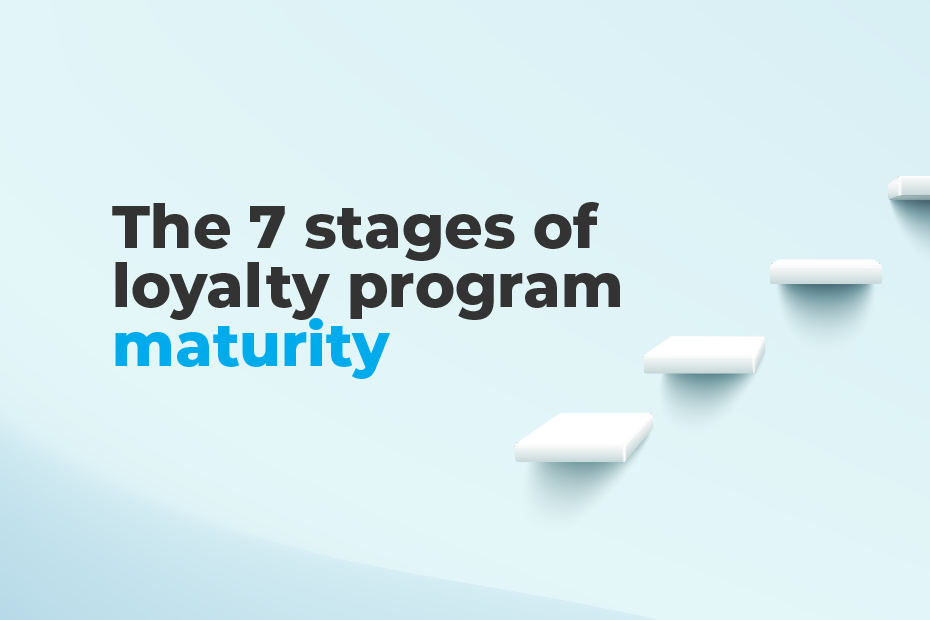How retailer maturity shapes loyalty success
A loyalty program is never just a marketing tool. It is a reflection of a company’s overall maturity – from marketing creativity to back-office operations, process efficiency, and IT infrastructure. As retailers grow, so does the complexity of their loyalty ecosystem.
In this post, we explore the 7 stages of loyalty program maturity. Each stage illustrates not only the evolution of program mechanics but also the digital maturity of the organization behind it – from initial setup to enterprise-wide integration and optimization.
Stage 1 – program launch
Every journey starts with the basics. At this stage, a retailer defines the purpose of its loyalty program – often focused on driving repeat purchases or boosting customer retention.
- Simple reward structures, usually points or discounts
- Initial KPIs such as sign-up rates or redemptions
- Minimal IT demands, often managed within CRM or POS systems
The focus is on proving the concept and creating a foundation for future growth.
Stage 2 – initial adoption
Once launched, the priority shifts to adoption and engagement. This stage tests both the program and the organization’s internal readiness.
- Onboarding flows via email, SMS, or push notifications
- Early incentives such as double points on first purchases
- Alignment of marketing teams with CRM processes
Here, IT maturity begins to matter – ensuring customer data is captured cleanly and integrated into back-office systems.
Stage 3 – points-based engagement
As programs scale, they move into a transactional stage focused on “earn and burn” mechanics. While effective initially, this stage highlights the need for reliable infrastructure.
- Tiered points and reward structures
- Integration with POS and eCommerce systems
- Reporting dashboards for redemptions and repeat rates
The challenge is no longer just marketing creativity – it is IT stability, data accuracy, and operational alignment across channels.
Stage 4 – personalization begins
This is where loyalty programs evolve from transactional to customer-centric. To achieve this, retailers require stronger digital maturity.
- Behavioral segmentation and targeted promotions
- Automated campaigns triggered by customer actions
- Integration between CRM, marketing automation, and analytics tools
At this stage, personalization is only as strong as the retailer’s ability to unify data across systems and departments.
Stage 5 – emotional loyalty takes root
True loyalty goes beyond rewards. Emotional connection requires coordinated brand experiences, content, and service delivery.
- Exclusive experiences and VIP tiers
- Surprise rewards and brand-value alignment campaigns
- Cross-department collaboration between marketing, service, and operations
Emotional loyalty depends on more than creativity – it requires organizational maturity where departments and systems work seamlessly together.
Stage 6 – community & advocacy
At this stage, loyalty evolves into advocacy. Customers don’t just engage – they become part of the brand story.
- Referral programs rewarding both sides
- User-generated content and social sharing
- Brand ambassador or influencer programs
Behind the scenes, this requires advanced IT support for referral tracking, fraud prevention, and community management platforms – proving that advocacy is as much about infrastructure as it is about marketing.
Stage 7 – continuous optimization & innovation
The final stage is where loyalty becomes a dynamic growth engine powered by data and technology.
- Advanced BI tools track KPIs like retention and churn
- AI-driven personalization adapts in real time
- Gamification, streak-based rewards, and predictive offers tested continuously
- IT systems integrated across marketing, operations, and customer support
This stage reflects full digital maturity – where loyalty is not a silo but a company-wide capability, embedded into every process and customer interaction.
Final thoughts – loyalty reflects organizational maturity
Loyalty is not just a tactic or a marketing mechanic – it is a mirror of a retailer’s digital maturity. Programs that stagnate often reveal gaps in IT integration, back-office operations, or process alignment. Programs that thrive are built on strong infrastructure, unified data, and cross-functional collaboration.
With Loymax, retailers gain not just a loyalty platform but a strategic partner. Our no-code tools integrate into existing systems, support back-office processes, and provide the AI, BI, and automation required for continuous optimization.
👉 Request a consultation today and see how Loymax helps retailers progress through every stage of loyalty maturity: https://loymax.io/

